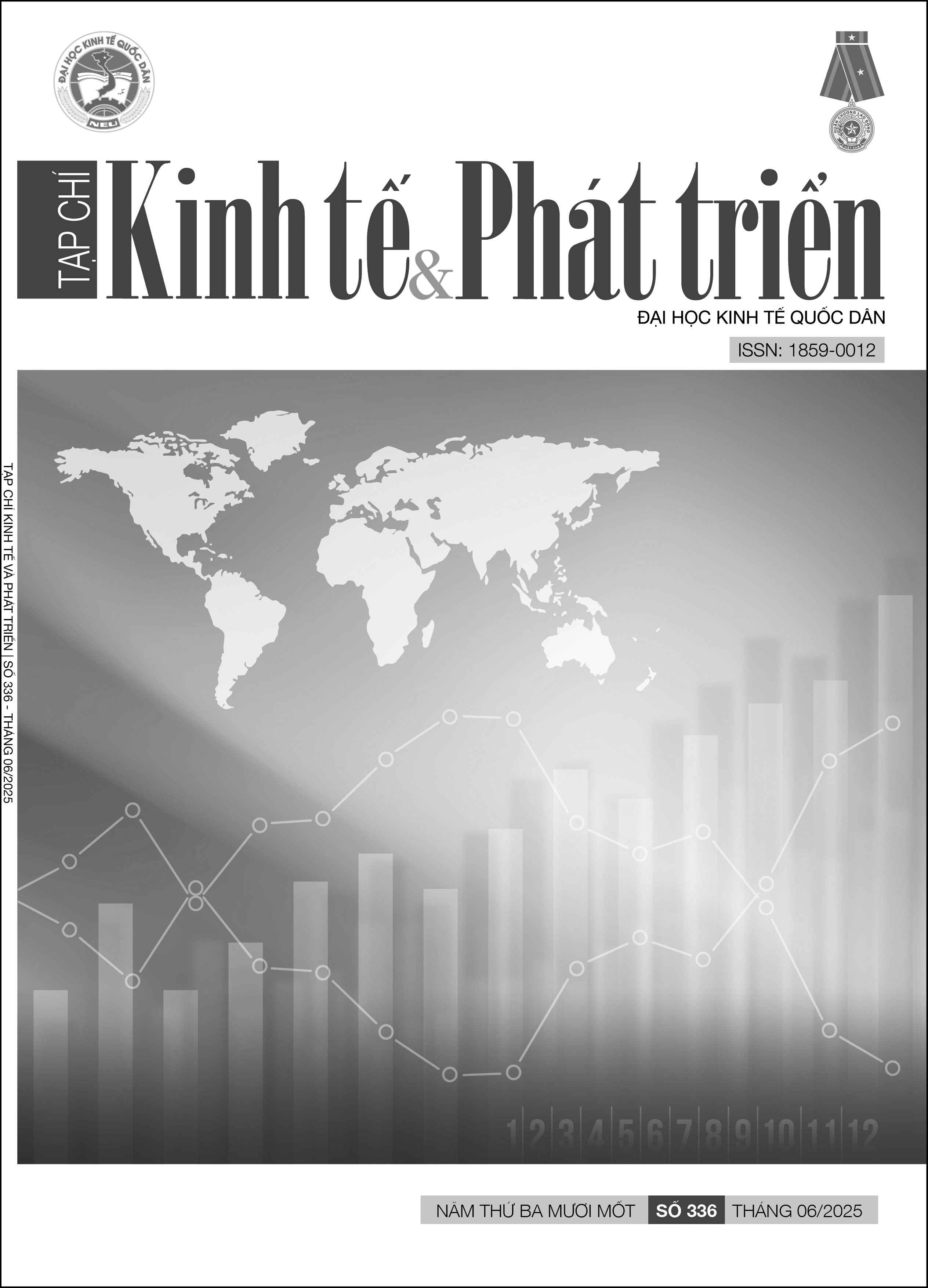Tác động bất đối xứng của lãi suất đến nợ xấu tại ngân hàng thương mại Việt Nam: Tiếp cận hồi quy phân vị
DOI:
https://doi.org/10.33301/JED.VI.2378Từ khóa:
Tác động bất đối xứng, lãi suất, nợ xấu, hồi quy phân vịTóm tắt
Bài viết nghiên cứu vai trò của lãi suất đối với tỷ lệ nợ xấu tại ngân hàng thương mại ở Việt Nam, tập trung vào tính phi tuyến và ngưỡng bất đối xứng. Kết quả hồi quy phân vị tại Việt Nam giai đoạn 2012-2024 cho thấy không chỉ hướng biến động (tăng hay giảm) mà cả mức độ thay đổi lãi suất cũng ảnh hưởng đến tỷ lệ nợ xấu. Cụ thể, biến động giảm của lãi suất có ảnh hưởng mạnh hơn đáng kể đến việc gia tăng nợ xấu so với biến động tăng. Đáng chú ý, nhóm ngân hàng có tỷ lệ nợ xấu trung bình (Q40, Q50, Q60) phản ứng bất đối xứng khi lãi suất giảm vượt ngưỡng 20%. Khi lãi suất giảm vượt ngưỡng này, tác động của chúng mạnh hơn so với mức giảm dưới 20%. Ngoài ra, nhóm ngân hàng có tỷ lệ nợ xấu cao ít bị tác động bởi biến động lãi suất. Điều này nhấn mạnh vai trò quan trọng của việc duy trì sự ổn định lãi suất trong kiểm soát rủi ro tín dụng và ổn định thị trường tài chính tại Việt Nam.
Tài liệu tham khảo
Akinlo, O. & Emmanuel, M. (2014), ‘Determinants of non-performing loans in Nigeria’, Accounting & taxation, 6(2), 21-28.
Amendola, A., Candila, V. & Gallo, G.M. (2019), ‘On the asymmetric impact of macro–variables on volatility’, Economic Modelling, 76, 135-152.
Anh, C.T. & An, N.N. (2023), ‘Impact of factors on non-performing loan at Vietnam Commercial Bank’, proceeding of International Conference on Research in Management & Technovation, Singapore: Springer Nature Singapore, 335-344.
Auronen, L. (2003), ‘Asymmetric information: theory and applications’, Seminar of Strategy and International Business, 167, 14-18.
Bahruddin, W.A. & Masih, M. (2018), ‘Is the relation between lending interest rate and non-performing loans symmetric or asymmetric? Evidence from ARDL and NARDL’, MPRA Paper 91565, MPRA.
Basel (2001), The new Basel capital accord, Consultative Document, Basle.
Bofondi, M. & Gobbi, G. (2004), ‘Bad loans and entry into local credit markets’, Economic working papers No.509, Bank of Italy, Economic Research and International Relations Area.
Castro, V. (2013), ‘Macroeconomic determinants of the credit risk in the banking system: The case of the GIPSI’, Economic Modelling, 31, 672-683.
Demirgüç-Kunt, A. & Detragiache, E. (1998), ‘The determinants of banking crises in developing and developed countries’, Staff Papers, 45(1), 81-109.
Espinoza, M.R.A. & Prasad, A. (2010), ‘Nonperforming loans in the GCC banking system and their macroeconomic effects’, IMF Working Paper WP/10/224, International Monetary Fund.
Ghosh, A. (2015), ‘Banking-industry specific and regional economic determinants of non-performing loans: Evidence from US states’, Journal of financial stability, 20, 93-104.
Kahneman, D. & Tversky, A. (2013), ‘Prospect theory: An analysis of decision under risk’, in Handbook of the fundamentals of financial decision making: Part I, World Scientific, 99-127.
Koenker, R. (2005), Quantile regression, Cambridge university press.
Koenker, R. & Bassett Jr, G. (1978), ‘Regression quantiles’, Econometrica: Journal of the econometric society, 46(1), 33-50.
Le, C.D.H. & Le, A.H. (2023), ‘Macroeconomic determinants of non-performing loans: A quantile regression approach evidence from Vietnam's banking system’, Journal of Eastern European and Central Asian Research, 10(5), DOI: https://doi.org/10.15549/jeecar.v10i5.1255.
Lien, N.T., Minh, N.T. & The, N.M. (2024), ‘Asymmetric thresholds of macroeconomic volatility's impact on stock volatility in developing economies: a study in Vietnam’, Journal of Economics and Development, 26(3), 224-235.
Llewellyn, D.T. (2002), ‘An analysis of the causes of recent banking crises’, The European journal of finance, 8(2), 152-175.
Maivald, M. & Teplý, P. (2020), ‘The impact of low interest rates on banks’ non-performing loans’, FFA Working Paper 2/2020, FFA.
Messai, A.S. & Jouini, F. (2013), ‘Micro and macro determinants of non-performing loans’, International journal of economics and financial issues, 3(4), 852-860.
Mishkin, F.S. & Eakins, S.G. (2019), Financial markets, Pearson Italia.
Nwanja, T.F., Ezie, O. & Oniore, J.O. (2024), ‘Analysis of transmission of monetary policy shocks on non-performing loans in Nigeria’, IRE Journals, 8(5), 252-266.
Schwartz, R.A. (1988), Equity markets, New York.
Siddiqui, S., Malik, S. & Shah, S. Z. (2012), ‘Impact of interest rate volatility on non-performing loans in Pakistan’, International Research Journal of Finance and Economics, 84(1), 66-75.
Stijepović, R. (2014), ‘Recovery and reduction of non-performing loans–podgorica approach’, Journal of Central Banking Theory and Practice, 3(3), 101-118.
Taylor, J.W. (2008), ‘Using exponentially weighted quantile regression to estimate value at risk and expected shortfall’, Journal of financial Econometrics, 6(3), 382-406.





